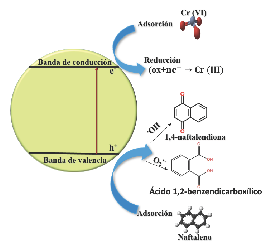 |
|
Hydrotalcite-like compounds (HTlc) ZnGa, CuGa and CuZnGa were synthesized with metal molar ratio x =0.29 by the coprecipitation method using microwave and ultrasound irradiation. In all the cases, the HTlc were obtained free of crystalline impurities, this was confirmed by X-ray diffraction patterns (XRD) with crystal sizes between 0.96-1.93 nm and specific surface areas from 35 to 75 m2/g. By scanning electron microscopy (SEM) different morphologies were identified: laminar, hexagonal and structures in the shape of a needle; the morphologies depend on the irradiation method and the metallic combination. The Band gap (Eg) values were lower than 3.0 eV, this allows their activation with visible light. The XRD of calcined HTlc support that the reflections correspond to mixed oxides of Cu, Ga and Zn. The calcined and uncalcined synthesized samples were evaluated in a combined adsorption-photodegradation process of the mixture Cr(VI)-naphthalene using visible light. It was found that the best tested material was the HTlc ZnGa calcined and synthesized by ultrasonic irradiation. This HTlc ZnGa was able to degrade the mixture of both contaminants up to 98% in comparison with the 35% of the commercial TiO2 anatase phase.
Keywords: hydrotalcite-like compound, microwave, ultrasound, naphthalene, chromium hexavalent.
|
|
 |

